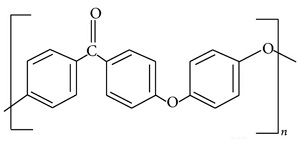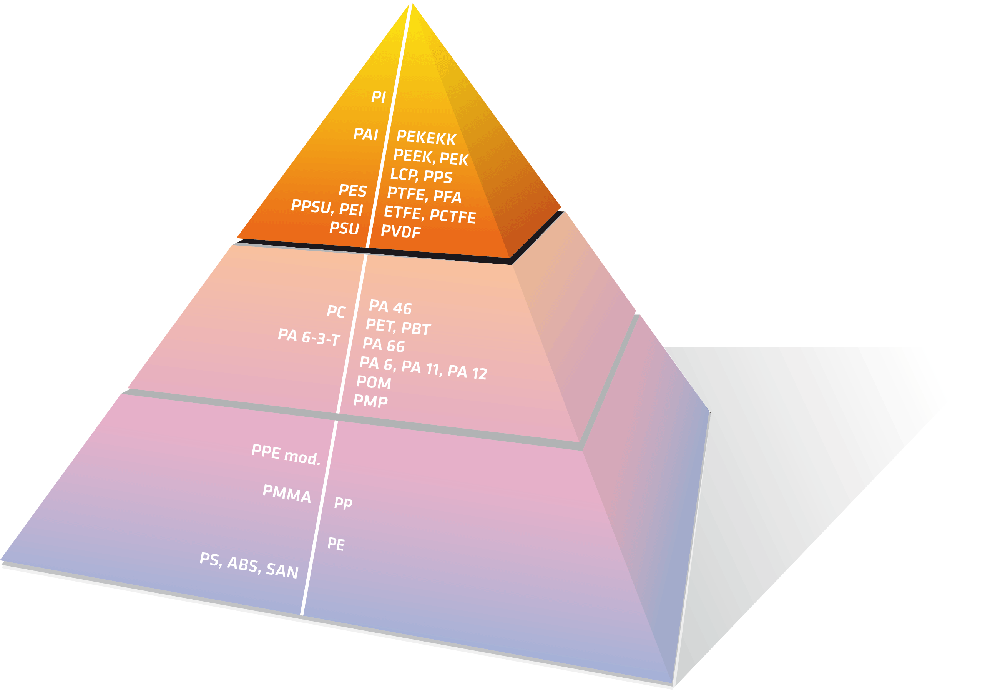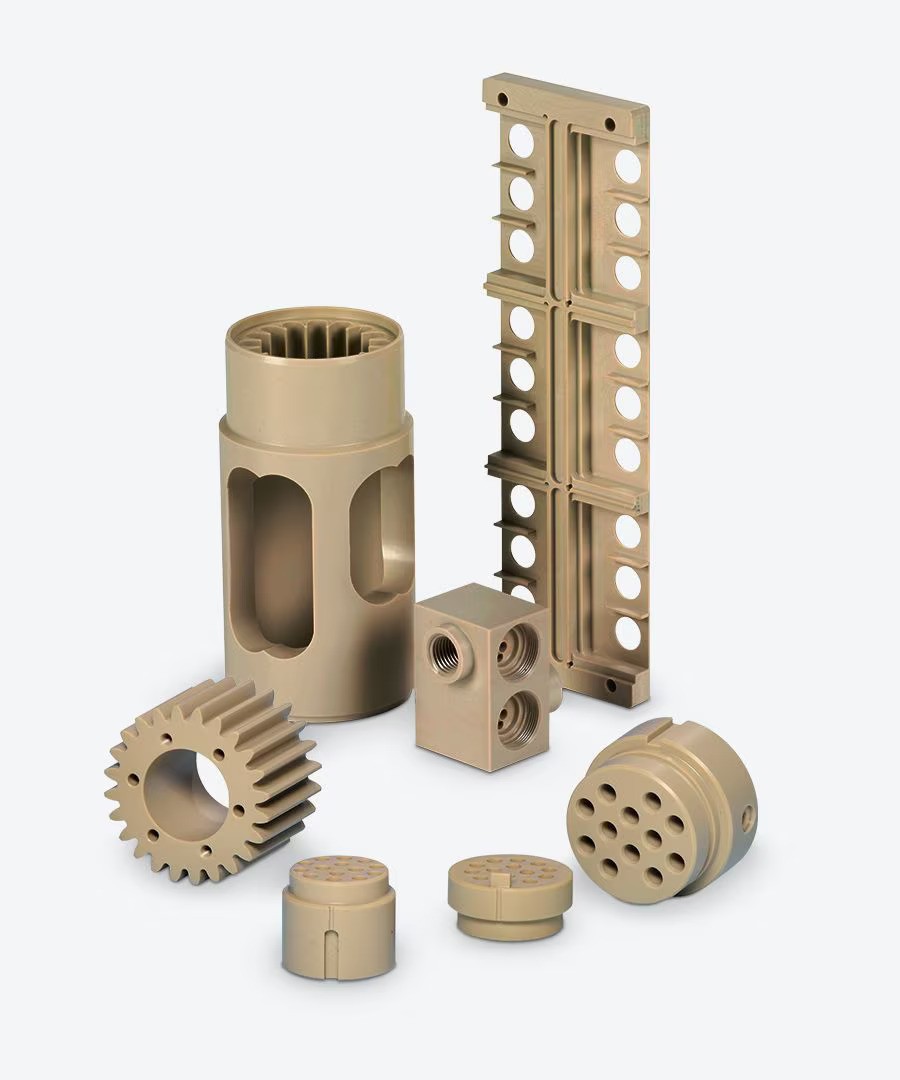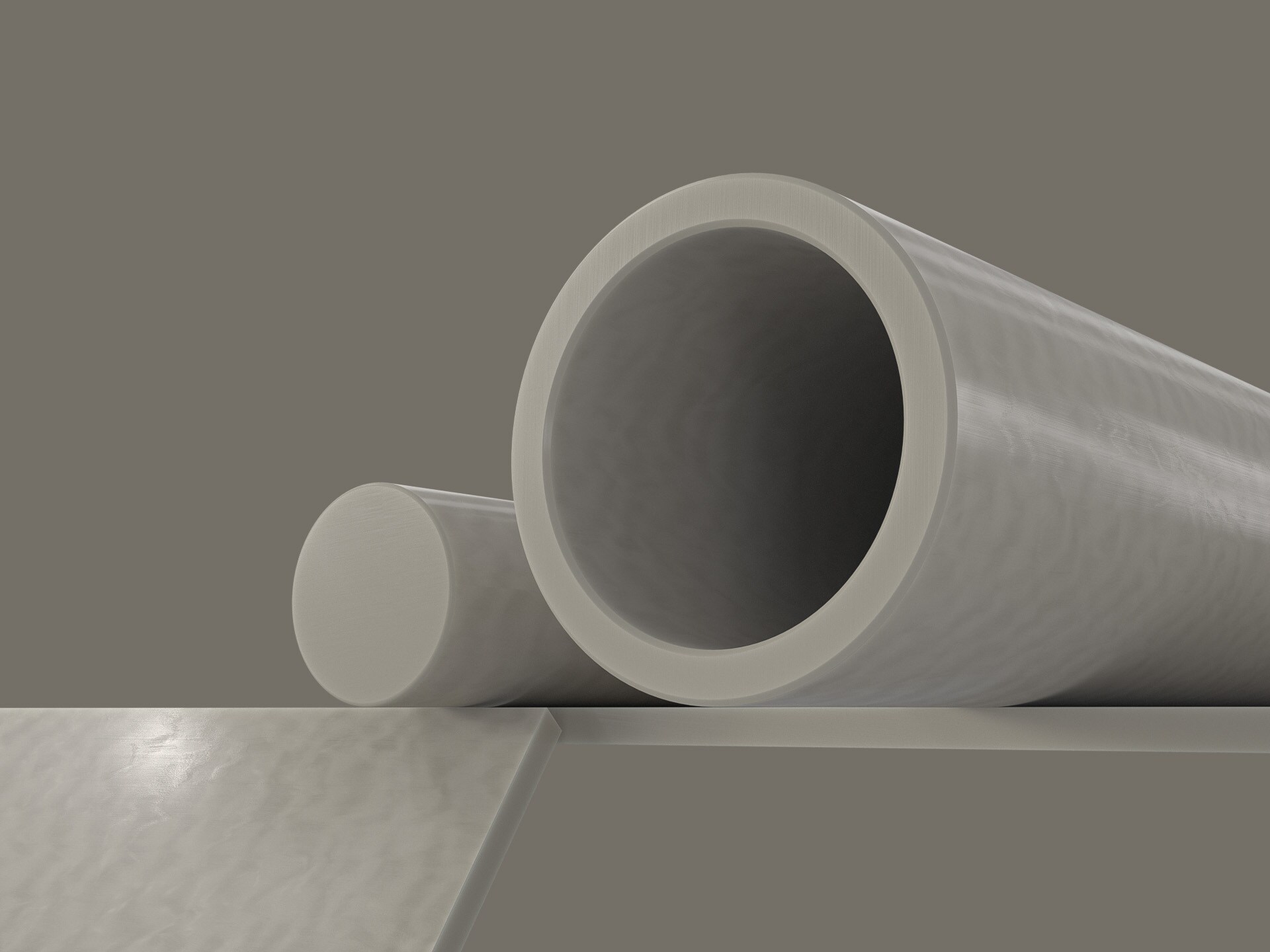What makes PEEK plastic so unique? As industries push for stronger, more heat-resistant materials, PEEK stands out. Polyetheretherketone (PEEK) is an advanced engineering plastic, developed in the 1980s, known for its high performance under extreme conditions.
In this post, you'll learn what PEEK is, its properties, and why it's crucial across multiple industries. We'll explore its unique characteristics and why it's a top choice for aerospace, medical, and automotive applications.

What is PEEK Plastic?
PEEK, or polyether ether ketone, is a high-performance engineering plastic. It's known for its exceptional properties and versatility across various industries. For more information on how PEEK is used in manufacturing, you can check out our guide on PEEK injection molding.
Chemical Composition and Structure
PEEK's molecular structure consists of repeating units of two ether groups and a ketone group. This unique arrangement gives PEEK its remarkable characteristics.

The chemical formula for PEEK is C19H14O3. Its CAS number is 29658-26-2.
Synthesis of PEEK
The production of PEEK involves several steps:
Monomer Preparation:
Key monomers: 4,4'-difluorobenzophenone and hydroquinone
Hydroquinone is treated with a strong base like sodium carbonate
Polymerization Process:
Occurs at high temperatures (around 300°C)
Takes place in a polar aprotic solvent (e.g., diphenyl sulfone)
Involves nucleophilic aromatic substitution
Isolation and Purification:
This process results in PEEK's stiff aromatic polymer backbone. It's why PEEK can withstand temperatures up to 240°C. Understanding these properties is crucial when considering injection molding tolerances for PEEK parts
Forms of PEEK
PEEK is available in various forms to suit different manufacturing processes:
| Form | Description |
| Pellets | Small, uniform granules for injection molding |
| Powder | Fine particles for compression molding, 3D printing |
| Rods | Stock shapes for machining custom parts |
| Granules | Similar to pellets, used in various molding processes |
Each form offers unique advantages for specific applications. Choosing the right form is crucial for optimal processing and performance.
Properties of PEEK Plastic
PEEK boasts a unique combination of properties. They make it suitable
Physical Properties
PEEK's physical characteristics make it stand out among engineering plastics:
Density: 1.26 - 1.32 g/cm³
Appearance: Opaque, beige color
Crystallinity: Semi-crystalline structure
Its crystallinity imparts excellent resistance to various liquids. This feature also enhances PEEK's fatigue performance and dimensional stability.
Mechanical Properties
PEEK boasts impressive mechanical strength:
Tensile strength: 90-100 MPa
Tensile modulus: 3.5 - 3.9 GPa
Flexural strength: 170 MPa
Flexural modulus: 4.1 GPa
Impact resistance (notched Izod): 80-94 J/m
These properties remain stable even at elevated temperatures. PEEK's toughness and strength make it ideal for demanding applications, similar to other high-performance plastics like ULTEM (PEI).
Thermal Properties
PEEK's thermal characteristics are exceptional:
Melting point (Tm): 343°C
Glass transition temperature (Tg): 143°C
Heat deflection temperature (HDT): 152°C at 1.8 MPa
Thermal conductivity: 0.25 W/(m·K)
Coefficient of thermal expansion: 47 µm/(m·K)
These properties allow PEEK to maintain performance in high-temperature environments, which is particularly important in the plastic injection molding process.

Highest heat resistant plastic: PEEK
Chemical Properties
PEEK exhibits outstanding chemical resistance:
Resistant to most organic and inorganic chemicals
Excellent hydrolysis resistance (withstands steam, water, seawater)
High radiation resistance
It remains stable in harsh chemical environments. This makes PEEK ideal for corrosive applications.

PEEK Chemical resistance
Electrical Properties
PEEK's electrical characteristics are noteworthy:
Dielectric strength: 20 kV/mm
Volume resistivity: 16 x 10^15 Ω·cm
Surface resistivity: 10^13 Ω
These properties make PEEK an excellent insulator across a wide temperature range.
Other Notable Properties
PEEK offers additional benefits:
Wear resistance: Low coefficient of friction (0.25 dynamic)
Biocompatibility: Suitable for medical implants and devices
Flame retardancy: V0 rating (UL 94) down to 1.45 mm thickness
Its low moisture absorption (0.5% in 24 hours) contributes to dimensional stability. PEEK's inherent purity makes it suitable for clean room environments. These properties make PEEK a superior choice in many applications compared to other manufacturing methods like die casting.
Applications of PEEK Plastic

Aerospace
In aerospace, PEEK offers high performance and reliability. Common applications include:
PEEK's strength, stability, and weight savings are crucial in aerospace.
Automotive
PEEK withstands the harsh conditions in automotive environments:
Its chemical and heat resistance make PEEK a reliable choice.
Medical
PEEK is biocompatible and sterilizable. It's widely used in medical applications:
Surgical instruments
Endoscopic components
Orthopedic tools
Dental instruments
Implantable devices
Spinal implants
Orthopedic implants
Cardiovascular implants
Sterilization equipment
Trays and cases
Instrument handles
PEEK ensures patient safety and device longevity.
Electronics
In electronics, PEEK provides excellent insulation and stability:
PEEK maintains its properties in extreme conditions.
Oil & Gas
PEEK withstands the challenges of oil and gas environments:
Downhole equipment
Electrical connectors
Sensor housings
Valve components
Seals and backup rings
High-pressure seals
High-temperature seals
Chemical-resistant seals
It provides reliable performance in hostile conditions.
Food processing
In food processing, PEEK offers purity and wear resistance:
Fillers and scrapers
Valve seats and bearings
Non-contaminating valve seats
Corrosion-resistant bearings
Chemically inert components
PEEK ensures food safety and equipment durability.
Grades of PEEK Plastic
PEEK is available in various grades. Each offers unique properties tailored for specific applications.
Unfilled (virgin) PEEK
Unfilled PEEK is the purest form. It provides:
Excellent chemical resistance
High toughness and elongation (up to 150%)
Good electrical insulation
Natural color (beige)
It's ideal for applications requiring purity and cleanliness, such as semiconductor processing and medical devices.
Glass fiber reinforced PEEK
Glass fiber reinforcement enhances PEEK's properties:
Increased strength and stiffness (flexural modulus up to 10 GPa)
Higher thermal stability (HDT up to 315°C)
Better dimensional stability
Lower thermal expansion (CLTE down to 1.1 ppm/°C)
Typical grades contain 30% glass fiber. They're great for structural applications in automotive, aerospace, and industrial equipment.
Carbon fiber reinforced PEEK
Carbon fiber takes PEEK's performance to the highest level:
Highest strength and stiffness (tensile strength up to 300 MPa)
Excellent fatigue resistance
Superior wear resistance
Low thermal expansion (CLTE as low as 0.2 ppm/°C)
Black color
Grades with 30% carbon fiber are common. They're used in the most demanding environments, such as aerospace structures and high-performance automotive parts.
Bearing grade PEEK
Bearing grades are tailored for wear and friction applications:
Reduced coefficient of friction (as low as 0.10)
Enhanced wear resistance (up to 10x better than virgin PEEK)
Improved thermal conductivity (up to 2x higher)
Added lubricants (PTFE, graphite)
They're ideal for bushings, bearings, and seals in industrial equipment, pumps, and valves. PEEK bearing grades outperform traditional metal and plastic materials.
FDA compliant grades for food and medical
Some PEEK grades meet strict FDA requirements:
Food contact compliance (FDA 21 CFR 177.2415)
Biocompatibility (ISO 10993, USP Class VI)
Sterilization resistance (autoclave, gamma, EtO)
Natural or medical blue colors
They're used in food processing equipment, surgical tools, and implantable medical devices. Safety and purity are assured for the most sensitive applications.
| Grade | Properties | Applications |
| Unfilled | Purity, toughness | Semiconductor, medical |
| Glass Fiber (30%) | Strength, stability | Automotive, aerospace, industrial |
| Carbon Fiber (30%) | Highest performance | Aerospace, high-end automotive |
| Bearing | Low friction & wear | Bushings, seals, bearings |
| FDA Compliant | Food & medical safety | Surgical tools, implants, food processing |
Modifications and Enhancements of PEEK
PEEK can be modified to enhance its properties. Various additives and treatments are used. They tailor PEEK for specific applications.
Fillers and reinforcements
Fillers and reinforcements improve PEEK's mechanical and thermal properties:
The type and amount of filler are chosen based on the application requirements.
Annealing and stress relieving
Annealing and stress relieving optimize PEEK's properties:
Annealing
Stress relieving
Reduces internal stresses
Minimizes warpage and distortion
Improves machining and cutting performance
These treatments are often applied to machined or formed parts.
Chemical additives
Chemical additives extend PEEK's performance in harsh environments:
UV stabilizers
Protect against ultraviolet degradation
Maintain mechanical properties outdoors
Extend service life in sunlight
Flame retardants
They allow PEEK to be used in demanding applications safely.
| Modification | Effect | Applications |
| Glass fiber | Strength, stability | Structural, automotive |
| Carbon fiber | Highest performance | Aerospace, wear parts |
| Lubricants | Low friction & wear | Bearings, gears, seals |
| Annealing | Crystallinity, stability | Precision parts, chemical resistant |
| Stress relieving | Reduced warpage | Machined & formed parts |
| UV stabilizers | Outdoor durability | Exterior components |
| Flame retardants | Fire safety | Transportation, electronics |
Processing Techniques for PEEK Plastic
PEEK can be processed using various methods. Each has its own considerations. Let's explore the main techniques.
Injection molding
Injection molding is common for producing complex PEEK parts:
Proper setup is crucial for quality parts. Specialized equipment is needed due to the high temperatures.
Extrusion
Extrusion produces continuous PEEK profiles:
Profiles, films, tubes
Rods, sheets, and custom shapes
Thin films and membranes
Seamless and reinforced tubes
Cooling considerations
Controlled cooling for crystallinity
Water baths or cooling rolls
Annealing for dimensional stability
The cooling rate affects the final properties. It must be optimized for each product.
3D Printing
3D printing offers design freedom for PEEK parts:
PEEK is challenging to 3D print. But it enables unique, high-performance parts.
Machining
PEEK can be machined like metals:
Turning, milling, drilling
Tool selection and wear issues
Proper techniques yield tight tolerances. Tool wear can be significant due to PEEK's abrasiveness.
Other methods
PEEK can be processed in other ways:
Compression molding
Casting
Welding
These methods expand PEEK's processing options. They're used for specific applications and requirements.
| Method | Typical Applications | Key Considerations |
| Injection molding | Complex parts, high volume | High temperature, mold design |
| Extrusion | Profiles, films, tubes | Cooling, dimensional control |
| 3D Printing | Custom parts, prototypes | Warping, layer bonding |
| Machining | Precision parts, low volume | Tool wear, chip control |
| Compression molding | Simple shapes, thick parts | Preheating, pressure |
| Casting | Prototypes, small runs | Mold material, shrinkage |
| Welding | Joining, assembly | Surface preparation, parameters |
For a comprehensive understanding of plastic processing techniques, including those used for PEEK, you can refer to our guide on the plastic injection molding process.

Design Considerations for PEEK Parts
Wall thickness and geometry
Wall thickness affects strength, stiffness, and moldability:
Aim for uniform thickness (± 0.025 in/0.64 mm)
Avoid thick sections (>0.16 in/4 mm) to prevent sink marks and voids
Use ribs and gussets for reinforcement, with a thickness of 50-60% of the main wall
Design for draft angles (1-2°) to facilitate ejection and prevent distortion
Proper geometry optimizes material usage and ensures smooth mold filling and ejection. Use coring and hollowing to reduce thick sections and minimize material consumption.
Shrinkage and warpage control
PEEK has high shrinkage (1-2%) during cooling, which can lead to warpage:
Use uniform wall thickness to promote even cooling and shrinkage
Incorporate the expected shrinkage into the mold design (1.5% is a good starting point)
Balance gating and filling to ensure uniform flow and pressure distribution
Control the cooling rate and temperature to minimize differential shrinkage
Warpage occurs due to differential shrinkage between different part sections. It can be minimized through proper design (e.g., symmetric geometry) and processing (e.g., gradual cooling).
Creep and fatigue resistance
PEEK has excellent creep and fatigue resistance, but it can be further enhanced through design:
Avoid sharp corners and notches, which can concentrate stress and initiate cracks
Use generous radii (>0.06 in/1.5 mm) and fillets to distribute stress evenly
Orient reinforcement fibers in the direction of the main stress to maximize strength
Control stress levels and cycling to stay within the material's endurance limit
Designing for long-term loading is crucial to ensure reliable performance over the part's entire lifetime. Use ribbing and material accumulation in high-stress areas to improve strength and stiffness.
Wear and friction optimization
PEEK has good inherent wear and friction properties, which can be optimized through design:
Use smooth, polished surfaces (Ra <0.8 µm) to reduce abrasion and wear
Avoid abrasive contact with rough or hard surfaces, which can accelerate wear
Incorporate lubrication features such as oil grooves, reservoirs, or self-lubricating additives
Select appropriate mating materials (e.g., metal, ceramic) based on the tribological requirements
Proper design minimizes wear and friction, extending the service life of moving parts like bearings, gears, and seals. Consider using specialized bearing grades of PEEK for the most demanding applications.
Dimensional stability and precision
PEEK offers excellent dimensional stability due to its low moisture absorption and high glass transition temperature. Precision can be achieved through careful design and processing:
Use tight tolerances (±0.002 in/0.05 mm) for critical dimensions and fits
Allow for uniform shrinkage (1.5%) in the mold design to compensate for post-molding changes
Optimize gating and ejection to minimize distortion and residual stress
Consider post-molding annealing to relieve stress and improve stability
Precise, stable parts are essential for critical applications like aerospace, medical, and electronics. They ensure consistent performance, easy assembly, and long-term reliability.
| Design Aspect | Key Considerations | Benefits |
| Wall thickness | Uniform (±0.025 in), avoid >0.16 in, ribs 50-60% | Strength, moldability, minimal sink |
| Shrinkage and warpage | Balance gating, 1.5% allowance, gradual cooling | Dimensional accuracy, minimal distortion |
| Creep and fatigue | Radii >0.06 in, fiber orientation, stress control | Long-term reliability, high strength |
| Wear and friction | Smooth surfaces (Ra <0.8 µm), lubrication, material pairs | Extended service life, low friction |
| Dimensional stability | Tolerances ±0.002 in, uniform shrinkage, annealing | Precision, consistency, easy assembly |
Comparison of PEEK with Other High-Performance Plastics
PEEK is one of the highest-performing thermoplastics available. But how does it compare to other advanced materials? Let's take a detailed look.
| Property | PEEK | PEI | PPS | PTFE | PI |
| Max. Service Temp. (°C) | 260 | 170 | 240 | 260 | 400 |
| Tensile Strength (MPa) | 100 | 105 | 80 | 25 | 150 |
| Flexural Modulus (GPa) | 4.1 | 3.3 | 4.0 | 0.5 | 3.5 |
| Notched Izod Impact (kJ/m²) | 7 | 6 | 3 | 2 | 4 |
| Chemical Resistance | Excellent | Excellent | Excellent | Outstanding | Good |
| Wear Resistance | Excellent | Good | Good | Fair | Good |
| Coefficient of Friction | 0.10-0.25 | 0.20-0.35 | 0.15-0.30 | 0.05-0.10 | 0.10-0.25 |
| Moisture Absorption (%) | 0.5 | 1.2 | 0.05 | <0.01 | 1.5 |
PEEK vs. PEI (Ultem)
PEI (polyetherimide), known by the brand name Ultem, is another high-performance polymer:
PEEK has higher strength, stiffness, and thermal stability
PEEK tensile strength: 100 MPa, PEI: 105 MPa
PEEK flexural modulus: 4.1 GPa, PEI: 3.3 GPa
PEEK glass transition temperature (Tg): 143°C, PEI: 217°C
PEEK maintains its mechanical properties at higher temperatures (260°C vs. 170°C continuous use)
PEI has better dimensional stability, lower moisture absorption, and higher dielectric strength
Both have excellent chemical resistance and inherent flame retardancy
PEEK outperforms PEI in extreme temperatures and mechanical loading. PEI is a good choice for structural and electrical applications.
PEEK vs. PPS
PPS (polyphenylene sulfide) is a high-temperature semi-crystalline engineering plastic:
PEEK has higher strength, impact resistance, and wear resistance
PEEK tensile strength: 100 MPa, PPS: 80 MPa
PEEK notched Izod impact strength: 7 kJ/m², PPS: 3 kJ/m²
PPS has better chemical resistance, especially to strong acids, bases, and solvents
PEEK is more expensive but offers superior mechanical performance and thermal stability
PPS is easier to process (lower melting point) and has lower moisture absorption
PEEK is the top choice for demanding mechanical and tribological applications. PPS is suitable for chemically aggressive environments and cost-sensitive projects.
PEEK vs. PTFE
PTFE (polytetrafluoroethylene), known by the trade name Teflon, is a unique fluoropolymer:
PEEK has much higher strength, stiffness, and wear resistance
PEEK tensile strength: 100 MPa, PTFE: 25 MPa
PEEK flexural modulus: 4.1 GPa, PTFE: 0.5 GPa
PTFE has the lowest coefficient of friction (0.05-0.10) and best non-stick properties
PEEK can withstand higher temperatures in air (260°C vs. 260°C continuous use)
PTFE is more chemically inert and resistant to virtually all solvents
PEEK is better suited for structural, load-bearing, and wear applications. PTFE excels in low-friction, non-stick, and chemically inert uses.
PEEK vs. Polyimides (PI)
Polyimides (PI) are a family of high-temperature, high-performance polymers:
PEEK has higher toughness, impact strength, and wear resistance
PEEK elongation at break: 50%, PI: 10-30%
PEEK notched Izod impact strength: 7 kJ/m², PI: 3-5 kJ/m²
Some PIs, like PMR-15 and BPDA-PPD, can withstand even higher temperatures (up to 400°C)
PEEK is easier to process (thermoplastic vs. thermoset) and has better chemical resistance
PIs are often used as coatings, films, fibers, and composites
PEEK is the preferred choice for most demanding structural and tribological applications. PIs are used when the highest temperature resistance is needed, often in aerospace and electronics.
While this comparison focuses on high-performance plastics, it's worth noting that in some applications, these materials might compete with high-strength metals. For instance, in aerospace applications, engineers might need to choose between PEEK and high-strength aluminum alloys like 6061 and 7075 aluminum.
For less demanding applications, engineers might consider more common plastics like ABS (Acrylonitrile Butadiene Styren
Environmental and Sustainability Aspects of PEEK
Recyclability of PEEK
PEEK is a fully recyclable thermoplastic:
It can be remelted and reprocessed multiple times
Recycling methods include mechanical and chemical recycling
Recycled PEEK retains most of its original properties
It can be blended with virgin PEEK or other polymers
Recycling PEEK helps reduce waste and conserve resources. It's an important aspect of sustainable manufacturing.
Energy efficiency in production
The production of PEEK is relatively energy-efficient:
It uses a solvent-free process (high-temperature melt polymerization)
This reduces the need for energy-intensive solvent recovery
The raw materials are stable and don't require special handling
PEEK's high performance allows for lighter, more efficient designs
These factors contribute to lower energy consumption and emissions. They make PEEK an environmentally friendly choice.
Life cycle assessment
Life cycle assessment (LCA) studies show PEEK's sustainability benefits:
PEEK parts have a long service life, reducing replacement needs
They can replace heavier metal components, reducing fuel consumption
PEEK's high-temperature resistance enables more efficient processes
Its chemical resistance minimizes the need for protective coatings
Over its entire life cycle, PEEK offers environmental advantages. It contributes to resource efficiency and reduced emissions.
| Aspect | Benefit |
| Recyclability | Reduced waste, conserved resources |
| Energy efficiency | Lower consumption and emissions |
| Life cycle performance | Long service life, efficient designs |
Summary
PEEK plastic offers a unique combination of properties, including high strength, heat resistance, and chemical resistance. These properties enable PEEK to perform in demanding applications across industries like aerospace, medical, and automotive. By understanding PEEK's grades, processing methods, and design considerations, engineers can harness its full potential.
Tips: You maybe interested to the all plastics















